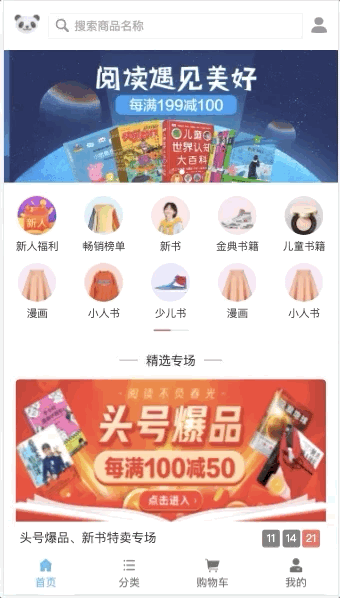主要讲下啥是 keep-alive、具体到项目中怎么用的问题。
项目相关:panda-mall
1、啥是 keep-alive?
-
就是缓存,我们还是来看看具体的使用场景。
-
首先简单一点,第一种比较普遍的场景,当我们从
首页–>列表页–>商详页–>再返回,这时候列表页应该是需要keep-alive的。 -
然后第二种,当我们从
首页–>列表页–>商详页–>返回到列表页(需要缓存)–>返回到首页(需要缓存)–>再次进入列表页(不需要缓存),这时候就是按需来控制页面的keep-alive了。
-
下面我们来说说在
vue中如何具体实现,我会说两种方式。
2、meta 路由元信息
(1)介绍
- 第一种就是使用 vue-router 提供的 meta 对象,给需要缓存如首页、列表页、商详等添加一个字段,用来判断用户是前进还是后退以及是否需要 keep-alive
(2)实现
- 首先我们需要在router.js的
meta对象里定义两个值:keepAlive:这个路由是否需要缓存deepth:深度,也就是页面之间的前进后退的层次关系
// 首页
{
path: '*',
name: 'Home',
// 路由懒加载:https://router.vuejs.org/zh/guide/advanced/lazy-loading.html
// webpackPreload:https://www.jianshu.com/p/bbdcfeee7fbc
component: () => import(/* webpackPreload: true */ '@/views/home'),
meta: {
keepAlive: true,
deepth: 1
}
},
// 商品列表
{
path: '/product',
name: 'Product',
component: () => import('@/views/product'),
meta: {
keepAlive: true,
deepth: 2
}
},
// 商品详情
{
path: '/detail',
name: 'Detail',
component: () => import('@/views/detail'),
meta: {
keepAlive: true,
deepth: 3
}
},
- 然后我们在app.vue中根据 meta 对象定义一下:
<template>
<div id="app">
<keep-alive :include="include">
<router-view v-if="$route.meta.keepAlive" />
</keep-alive>
<router-view v-if="!$route.meta.keepAlive" />
</div>
</template>
- 最后我们需要实时的监听路由:
export default {
data() {
return {
include: []
};
},
watch: {
$route(to, from) {
// 如果要to(进入)的页面是需要keepAlive缓存的,把name push进include数组中
if (to.meta.keepAlive) {
!this.include.includes(to.name) && this.include.push(to.name);
}
// 如果 要 form(离开) 的页面是 keepAlive缓存的,
// 再根据 deepth 来判断是前进还是后退
// 如果是后退:
if (from.meta.keepAlive && to.meta.deepth < from.meta.deepth) {
const index = this.include.indexOf(from.name);
index !== -1 && this.include.splice(index, 1);
}
}
}
};
- 上面这个就是大佬所实现的主要步骤,一共其实就两步:
设置meta、监听路由并判断。这里有一定要注意的是:你的路由中定义的 name 和页面中定义的 name 一定要全等,并区分大小写!!!
// router.js
{
path: '*',
name: 'Home', // name要大小写要一致
component: () => import(/ '@/views/home'),
meta: {
keepAlive: true,
deepth: 1
}
}
// home.vue
export default {
name: 'Home', // name要大小写要一致
}
3、hack 手法
(1)问题
- 从上面我们可以看到,其实设置起来还是挺严格的,就拿
name一致来说,如果团队里面大家从一开始就都定义了一个规范那还好说,但是往往大家就name保持一致这个就可能很难。
(2)实现
- 所以我们可以这样设置,首先我们肯定还是要利用
meta.keeAlive字段来进行判断的,但是不用定义deepth深度了。
// 首页
{
path: '*',
name: 'Home',
component: () => import('@/views/home'),
meta: {
keepAlive: true
}
},
// 商品列表
{
path: '/product',
name: 'Product',
component: () => import('@/views/product'),
meta: {
keepAlive: true
}
},
// 商品详情
{
path: '/detail',
name: 'Detail',
component: () => import('@/views/detail'),
meta: {
keepAlive: true
}
},
- 进入到app.vue页面中我们为
<router-view>添加一个key,这个key就像是我们使用v-for循环所定义的一样,大家都知道,key的作用就是一个标识对吧,作用于vue在虚拟 dom 进行diff算法,提高渲染效率。
<template>
<div id="app">
<keep-alive>
<router-view v-if="$route.meta.keepAlive" :key="key" />
</keep-alive>
<router-view v-if="!$route.meta.keepAlive" :key="key" />
</div>
</template>
<script>
export default {
computed: {
key() {
return this.$route.fullPath;
}
}
};
</script>
- 然后我们对其需要强制刷新的页面参数里加个时间戳,这样就可以实现按需
keep-alive了。
onClick() {
this.$router.push({
path: '/product',
query: {
t: +new Date()
}
})
}
3、小结
- 两者相比,我觉得可能第二种更加的实用,比一种简单,但是有丑,因为会带串时间戳字符串如:
http://localhost:8081/#/product?t=1585898137794 - 第一种算是比较完美,其实设置起来也不难,只是对团队人员的规范性要求比较高。
- 我们panda-mall项目中使用第二种方案,大家可以根据自己的背景任意选择一种方案,或者有更好的方案可以留言一起学习学习,






 随时随地看视频
随时随地看视频




热门评论
-

yoyo不是小孩2020-04-14 0
查看全部评论感谢!